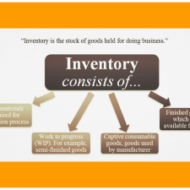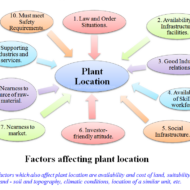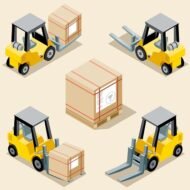Posted by Managementguru in Management Accounting
on Mar 8th, 2015 | 0 comments

Gross Profit It is a required income statement entry that indicates total revenue minus cost of goods sold. It is the company’s profit before operating expenses, interest payment and taxes. It is also known as GROSS MARGIN. The gross profit on a product is computed as: Net Sales – Cost of Goods Sold (COGS) This concept is well understood if you are able to clearly distinguish between variable and fixed costs. VARIABLE COSTS: Materials used Direct labor Packaging Freight Plant supervisor salaries Utilities for a plant or a warehouse Depreciation expense on production equipment Machinery FIXED COSTS: Fixed costs generally are more static in nature. They include: Office expenses such as supplies, utilities, a telephone for the office, etc. Salaries and wages of office staff, salespeople, officers and owners Payroll taxes and employee benefits Advertising, promotional and other sales expenses Insurance Auto expenses for salespeople Professional fees Rent Variable expenses are logged as cost of goods sold. Fixed expenses are counted as operating expenses (sometimes called selling and general administrative expenses). While gross profit is a monetary entity, the margin is expressed as a percentage. It’s equally significant to track since it allows you to keep an eye on profitability trends. Gross Profit Ratio = Gross Profit / Net Sales The gross profit margin is computed as follows: When the ratio is expressed in percentage form, it is known as gross profit margin or percentage. Gross Profit / Net Sales *100 = Gross Profit Margin It is equal to the net sales minus cost of goods sold and net sales are equal to total gross sales less return inwards and discount allowed. Benefits of calculating gross profit: This ratio determines how efficiently the management utilizes labor and raw materials A company uses its gross income to fund activities such as research and development, marketing etc., which are vital for generating future sales. A prolonged decline in this margin is a cleat-cut indication of sales drop-down and ultimately earnings. Trends in this margin reflect basic pricing decisions and material costs of a company. This profit margin is an accounting measure designed to estimate the financial health of a business or industry. It may be noted that generating a profit margin alone cannot vouch for the financial health of a firm; rather the business must have sufficient cash flow in order to pay its bills and compensate employees. An entrepreneur might compare the return that would be available from a bank or another low-risk investment opportunity to that of his EXISTING profit-margin to gauge whether his startup is doing well. → Profitability...

Posted by Managementguru in Business Management, Operations Management
on Feb 18th, 2015 | 0 comments

Inventory Control Learning Objective: To know the meaning, types and functions of inventories Meaning of Inventory: The word inventory refers to any kind of resource having economic value and is maintained to fulfil the present and future needs of an organization. Fred Hansman has defined Inventory as “An idle resource of any kind provided such a resource has economic value”. Such resources may be classified into three categories: A. Physical resources such as raw materials, semi-finished goods, finished goods, spare parts, lubricants etc. B. Human resources such as unused labor (man power) and C. Finance resources such as working capital etc. Inventory of resources is held to provide desirable service to customers and to achieve sales turnover target. At the same time holding big inventory severely affects the cash flow and working capital of an organization if the production vs demand cycle is not stream-lined. Because inventory often represents more than 25% of total assets and therefore it becomes very essential to maintain an optimal level of inventory in each resource so that the total inventory cost is near its minimum. Functions of Inventory: Inventory serves several important functions that add flexibility to the operations of a firm. Provides stock of goods to meet the anticipated demand of customers. In the case of consumer goods with a seasonal demand, the establishment of inventories in distribution and production warehouses also ensures that production can run continuously at full capacity despite swings in seasonal demand. De-Coupling function: The down time in one manufacturing stage should not affect the whole manufacturing process and this vital purpose is solved by holding inventory which acts as a buffer between successful stages of production. Quantity Discounts: Many suppliers offer QD’s for large orders of inventory. Procurement warehouses can result from a company’s desire to get volume discounts from a supplier or more favorable conditions from a carrier. Price speculation – Inventory also helps to hedge against inflation and price changes. Inventories of procurement and distribution warehouses are increased if the price of a good is expected to rise. In such a situation, the purchasing company aims to amass the good at the current low price. The supplier may speculate that supply shortages will drive the prices higher, and he uses the warehouse to store the good. Shortages can occur regularly due to irregular supply of raw materials, weather, quality problems or improper deliveries. Inventory shall act as “safety stock’ – extra goods on hand which reduce the risk of stock-outs. Helps to permit operations to continue smoothly with the use of “work in process” inventory. This is because it takes time to make goods and because a pipeline inventory is stocked through-out the process. JUST IN TIME MANUFACTURING CONCEPT Types of Inventory: Inventory can be classified according to the basis of type of material maintained in the firms and also on the basis of the functions they tend to perform in an organization. On the basis of type of material, the firms maintain four types of inventories: Raw material inventory Work in process inventory Maintenance/operating supply (MRO) inventory and Finished goods inventory Raw material inventory is the one which has been purchased and yet to be processed. The work in process material has undergone some change but is not completed. Work in process exists because of the time it takes for a product to be made which is called the “CYCLE TIME.” MRO inventory is devoted to maintenance/repair/operating supplies. They exist because the need and timing for maintenance and repair of some equipment are unknown. Products completed and waiting for shipment are called finished goods inventory. Finished goods may be inventoried because customer demand for...

Posted by Managementguru in Operations Management, Project Management
on Feb 24th, 2014 | 0 comments

Locational Attributes for a Plant Layout The location of an industrial plant plays a vital role in determining its success. Management should weigh the pros and cons of the location in terms of cost and revenue as each location might influence these variables in different proportions. Let us try to understand the need for a new facility location. Entrepreneurs interested in starting a new business venture or a small-scale enterprise has to look out for appropriate location for plant installation. Manufacturers who plan to expand their product range needs additional plant capacity Multinational corporations trying to establish their markets through subsidiaries Obsolete plants have to be shut down and new location has to be identified. The location attributes described below are fundamental in the decision to locate an industry. Although for particular firms some are more important than others, a significant shortfall in an area’s ability to provide even one of these may greatly reduce the attractiveness of that site. Labor The management will be interested in such locations where there is adequate supply of labor. Some operations need skilled labor and some unskilled. The cost of labor is an important factor to be considered as it influences labor productivity. However, low labor cost is not necessarily an advantage, if the workers are poorly educated and trained. The management has to be mentally prepared to pay for skilled labor who have the training and experience needed for the planned operation. Energy resources Electricity and water are major energy resources needed for production activities. For example, a textile mill needs to have round the clock power supply, for continuous production and a dyeing plant is in need of copious water supply. These industries will be on the look out for a location that has abundant energy resources available at low cost. Transportation The industry has to be located near the market so that the produce can quickly reach the market making the transportation costs minimum. Domestic trade heavily relies upon road transport as there are numerous service providers and there is well-developed infrastructure connecting even the remotest of locations. International trade takes place through either airways or waterways. In places like Kerala, inland waterways help in transporting merchandise within the domains of the territory. Raw materials availability Many businesses depend on materials of various types such as unprocessed raw materials for use in manufacturing and finished goods for inventory, in wholesale and retail establishments. The availability and cost, including transportation costs of these materials are critical location factors. Other Factors Other factors that influence location decisions are government regulations, climate and environmental quality of an area, soil texture, and attitudes of state and local governments’ etc. The economic viability of a project is undoubtedly enhanced by appropriate location. The location should also conform to environmental protection laws to maintain the ecobalance of that particular habitat. Organizations are expected to dispose of with the effluents in a systematic manner and this has to be kept in mind while choosing a location. The GEMBA Walk: A gemba (and sometimes genba) walk is the term used to describe personal observation of work – where the work is happening. The original Japanese term comes from gembutsu, which means “real thing.” It also sometimes refers to the “real...

Posted by Managementguru in Operations Management, Project Management
on Feb 24th, 2014 | 0 comments

Materials Handling Minimize Movement and Maximize Productivity Manufacturing organizations handle many types of materials in their production environment. Raw materials, materials-in-progress, finished goods, accessories, components, packaging materials, maintenance and repair supplies, scrap and many more must be handled in an efficient manner to make the operations cost-effective and to avoid wastage. The principle behind material handling process is said to be “no handling”, which is not practicable in reality. So it would be appropriate to say, that the objective of materials handling would be, to reduce the number of handlings as well as reducing the distances through which the materials are handled. Why efficient materials handling is inevitable in a manufacturing set-up? The movement of materials from the receiving area to the shipping area through the production line does not add value to the product but only to the cost. Further, plant layout and materials handling are complementary to each other. A production facility must incorporate a good plant layout that enhances the efficiency of movement of materials with ease and should deliver maximum productivity. Principles for Efficient Materials Handling There are certain principles that serve as a guide for efficient materials handling. These provide a framework for selecting specific materials handling equipments that form the core of the production system. Eliminate handling-If not, reduce the distance travelled by the materials Keep moving-If not, reduce the time spent at crucial points Simple patterns of material flow is appreciated-If not, reduce back tracking, cross overs, congestion Carry pay loads Carry full loads Use reliable and inexpensive source of power Materials handling should be considered in the light of movement of men, machines, tools and information. It also depends on the type of product manufactured, quantity, value and size of the organization. Cost effectiveness can be achieved if the firm is able to reduce the manufacturing cycle time through faster movement of materials and thus work-in-progress inventory costs can also be controlled and reduced. Design of the plant layout that facilitates sequential flow of materials through the production facility, improved working conditions, safety in the movement of materials, contribution to better quality by avoiding damage to the materials due to inefficient handling and workers being appraised about the importance of smooth materials handling result in higher productivity at lower manufacturing cost. Interested in being served food by Robots! Factors to considered while deciding on material handling equipments: Adaptability, flexibility, load capacity, power, speed, nature of supervision required, space requirements, ease of maintenance, environment friendliness and cost are some of the factors to be taken into consideration while deciding on the type of material handling equipments. Also the capabilities of manpower to operate the equipment and safety of personnel cannot be overlooked. It is important to select and design, materials handling system that are expensive to purchase and operate. For instance, if overhead cranes are to be used, the structure of the building should be strong enough to support the installation. Spacious aisles are mandatory if the loads are heavy and transported across the shop floors. Equipments used: Elevators, hoists, industrial trucks like fork-lift trucks, pallet trucks, pipelines, automatic transfer devices, automated guided vehicles, and industrial robots are some of the handling equipments that have found their ideal place in this process. Materials handling activity should be evaluated like any other activity to gauge its effectiveness. The focus should be on the manufacturing cycle efficiency, equipment utilization, percentage of time lost, total number of moves and material handling costs as percentage of manufacturing...








